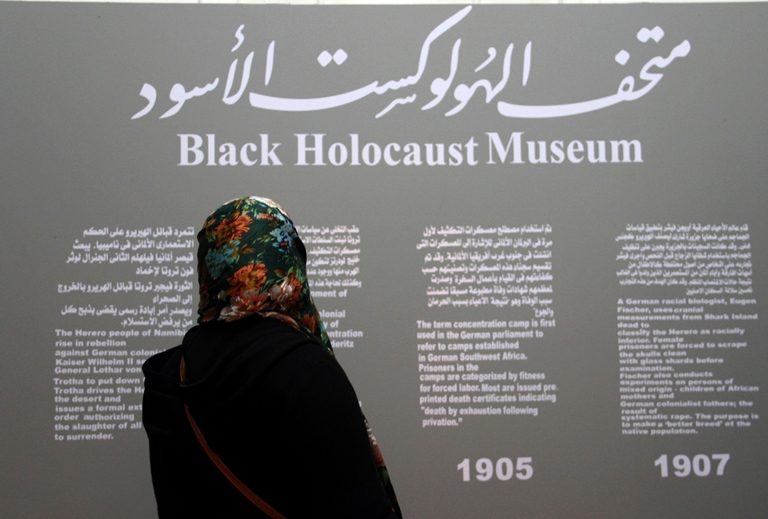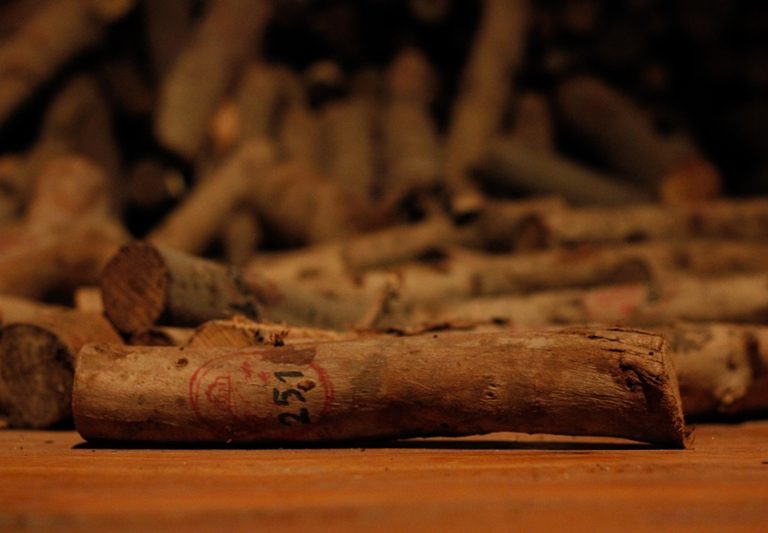Black Holocaust Museum
Installation. Cairo, Egypt, 2014
©Alexia Clorinda, Cultural Critic/Art Historian
The Black Holocaust Museum is a disquieting installation rescuing the memory of the genocide of Herero and Nama people in South West Africa, committed by the Nazis during the colonization.
As Frantz Fanon said,”colonialism cannot be understood without the possibility of torturing, violating or massacring”.
Indeed. Slavery and genocide was a constitutive part of the European imperial world, sustained by the politics of race, which constructed the other as primitive and savage.
At the first place, the title’s installation might destabilize the monopoly of the term Holocaust never used to refer to the atrocities committed by Nazis during the colonial expansion and exclusively referred to the Jew-centric signification to ensure the Memorabilia of the Shoah.
Why actually there is not already a Museum Holocaust of the history of colonialism?
Indeed, this seems a memory judged too dangerous to social stability to activate and create.
Artist Amado Alfadni positions his duty in creating consciousness, recalling what is forgotten and making possible an encounter with memory visualized by the installation.
The mountain of accumulated woods pieces, raw anthropological material of funeral rites, is a heavy atmosphere, barely sketching in, evoking the bodies locked up, chained, forced to labor, beat and killed.
The accumulating effect is devastating.
The weight of history is there.
The horror of the concentration camp, the violence of the colonial world and its lies, cruelty, and mediocrity.
There is a shame to acknowledge this history of violence.
One should feel obliged to think about what it means to look at this work and assimilate what it shows.
Let’s this memory haunt us and try to learn, to remember what human beings are capable of doing to one another and deepen our sense of reality.
No one has the right to amnesia.
Images of the Black Holocaust museum
The Hereo Holocaust/genocide took place between 1904 and 1908 and is considered the first holocaust of the 20th century. It occurred in German South-West Africa (modern-day Namibia) during the European colonialist scramble for territory in Africa. In total, somewhere between 80,000 and 110,000 people, around 85% of Herero and Nama tribes’ people, were killed. The holocaust came after a huge propaganda campaign in Europe that depicted the tribes’ people as dangerous savages who were attacking and killing European settlers. After slaughtering the Herero at the battle of Waterberg in 1904, General Lothar von Trotha wrote the extermination order:
“I, the great General of the German soldiers, send this letter to the Herero
people. The Herero are no longer German subjects. The Herero nation
must leave the country. If they do not leave, I will force them out with the
Cannon. Every Herero, armed or unarmed…will be shot dead within the
German borders. I will no longer accept women and children, but will force
them back to their people or shoot at them.”
The Herero were pushed into the desert past the last waterholes, guards were stationed to prevent their return, the wells were poisoned, and the Herero were left to die of thirst and starvation in the Omaheke (Kalahari) desert. Survivors, the majority of whom were women and children, were eventually put in concentration camps, such as that at Shark Island, where the German authorities forced them to work as slave labour for German military and settlers. Roughly 3,000 Herero died at the Shark Island camp.
Five official and several private concentration camps were established in Namibia at this time for the purpose of containing and ultimately exterminating the Herero and Nama. Nearly 10,000 people would die in these camps. The Shark Island Extermination Camp was built by the Second Reich and is regarded as the world’s first extermination camp (Vernichtungslager). It was designed by Franz Xavier Ritter von Epp, a man who was to inspire Hitler in the genocide of Jews and Gypsies in World War II.
Eugen Fischer, a German racial biologist, traveled to the concentration camps to conduct medical experiments to prove that the indigenous people of German southwest Africa were of an inferior race to the German settlers. Other experiments were made by Dr. Bofinger, who injected Herero suffering from scurvy with various substances including arsenic and opium; afterward, he researched the effects of these substances by performing autopsies on dead bodies. An estimated 2,000 skulls were sent to Germany for further experimentation.
The identities of Shark Island’s 3,000 victims remain unknown; they were registered only by numbers assigned on entry. Each prisoner was identified by a tag, many of which were reused after the original tag holder was killed. The only record of the Shark Island victims is photography taken for the experiments or as mementos for the soldiers’ families and friends back home.
The Holy Fire
In the Herero funerary tradition, a person bearing the same name as the dead would burn a holy fire after sunset in order to release the soul and allow it to ascend to heaven. The installation contained 3,000 pieces of wood, engraved with numbers given to them by the Germans, representing the souls of the victims of Shark island concentration camp, whose souls were never released, because their names were lost. The installation also included audio describing images of the victims taken from German archives and postcards.





